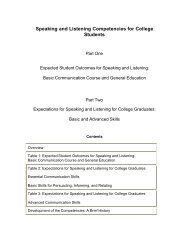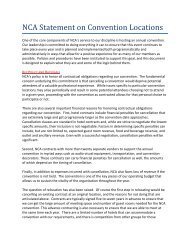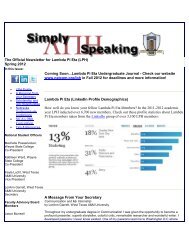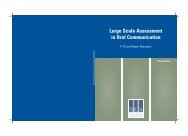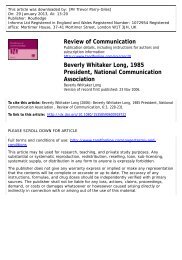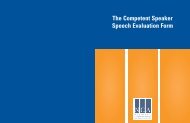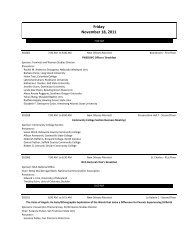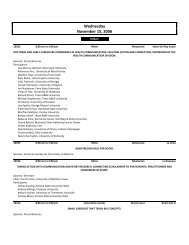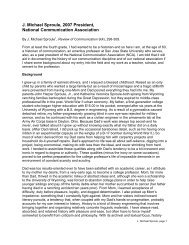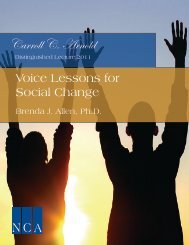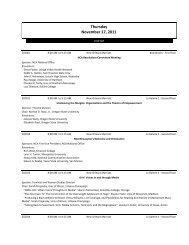Assessing Motivation to Communicate - National Communication ...
Assessing Motivation to Communicate - National Communication ...
Assessing Motivation to Communicate - National Communication ...
- No tags were found...
Create successful ePaper yourself
Turn your PDF publications into a flip-book with our unique Google optimized e-Paper software.
THE NATIONAL COMMUNICATION ASSOCIATION’SCRITERIA FOR THE ASSESSMENT OF ORAL COMMUNICATIONA <strong>National</strong> ContextAssessment has received increasing attention throughoutthe 1970s and in<strong>to</strong> the 1990s. Initially appearing inthe standards developed by state depart-mints of education,by 1980 over half of the states had adopted statewidestudent-testing programs. In Educational Standardsin the 50 States: 1990, the Educational TestingService reported that by 1985, over 40 states had adoptedsuch programs, and between 1985 and 1990, anadditional five states initiated statewide student- testingprograms, bringing the number of such program <strong>to</strong> 47.During the 1970s and 1980s, the number of differentsubjects and skills tested has also consistently increased,with additional attention devoted <strong>to</strong> how assessmentsare executed. Moreover, during this period, organizations,such as the <strong>National</strong> Assessment of EducationalProgress, intensified and expanded the scope of their assessmentprocedures as well as extensively publicizedthe results of their findings nationally and annually.By the end of 1989, the public recognized the significanceof national educational assessments. In the PhiDelta Kappan-Gallup poll reported in the September1989 issue of Phi Delta Kappan, 77 percent of the respondentsfavored “requiring the public schools in thiscommunity <strong>to</strong> use standardized national testing programs<strong>to</strong> measure academic achievement of students,”and 70 percent favored “requiring the public schoolsin this community <strong>to</strong> conform <strong>to</strong> national achievementstandards and goals.”Likewise, <strong>to</strong>wards the end of the 1980s, colleges anduniversities began <strong>to</strong> realize that formal assessment issueswere <strong>to</strong> affect them. For example, in its 1989-1990Criteria for Accreditation, the Southern Association ofColleges and Schools--which provides institutional certificationfor over 800 colleges and universities in theSouth-held that “complete requirements for an associateor baccalaureate degree must include competence inreading, writing, oral communications and fundamentalmathematical skills.” They also held that the generaleducation core of colleges and universities “mustprovide components designed <strong>to</strong> ensure competence inreading, writing, oral communication and fundamentalmathematical skills.”In 1990, a series of reports appeared which suggestedthat systematic and comprehensive assessment shouldbecome a national educational objective. In February1990, for example, the <strong>National</strong> Governors’ Association,in the context of President George H.W. Bush’s se<strong>to</strong>f six educational goals, argued that, “<strong>National</strong> educationgoals will be meaningless unless progress <strong>to</strong>wardmeeting them is measured accurately and adequately,and reported <strong>to</strong> the American people.” The nation’sgovernors argued that “doing a good job of assessment”requires that “what students need <strong>to</strong> know mustbe defined,” “it must be determined whether they knowit,” and “measurements must be accurate, comparable,appropriate, and constructive.” In July 1990, PresidentBush reinforced this line of reasoning in The <strong>National</strong>Education Goals: A Report <strong>to</strong> the Nation’s Governors.And, in September 1990, the <strong>National</strong> Governors Associationextended and elaborated its commitment <strong>to</strong>assessment in Educating America: State Strategies forAchieving the <strong>National</strong> Education Goals: Report of theTask Force on Education.Additionally, in 1990, in their report From Gatekeeper<strong>to</strong> Gateway: Transforming Testing in America,the <strong>National</strong> Commission on Testing and Public Policyrecommended eight standards for assessment, arguingfor more humane and multicultural assessment systems.Among other considerations, they particularlymaintained that “testing policies and practices must bereoriented <strong>to</strong> promote the development of all human talent,”that “test scores should be used only when theydifferentiate on the basis of characteristics relevant <strong>to</strong>the opportunities being allocated, and that “the moretest scores disproportionately deny opportunities <strong>to</strong> minorities,the greater the need <strong>to</strong> show that the tests measurecharacteristics relevant <strong>to</strong> the opportunities beingallocated.”NCA’s Assessment ActivitiesThe evaluation and assessment of public address hasbeen of central concern <strong>to</strong> the discipline of communicationsince its inception and <strong>to</strong> the <strong>National</strong> <strong>Communication</strong>Association when it was organized in 1914. In 1970,NCA formalized its commitment <strong>to</strong> assessment when itcreated the Committee on Assessment and Testing (nowknown by the acronym CAT) for “NCA members interestedin gathering, analyzing and disseminating informationabout the testing of speech communication24 <strong>Assessing</strong> <strong>Motivation</strong> <strong>to</strong> <strong>Communicate</strong>




